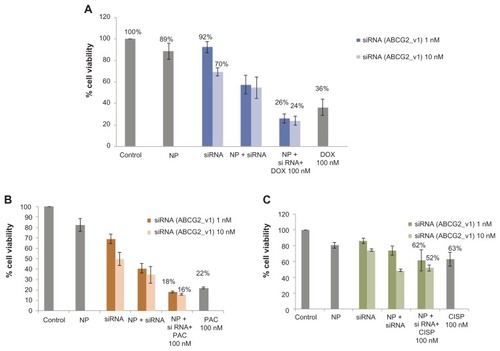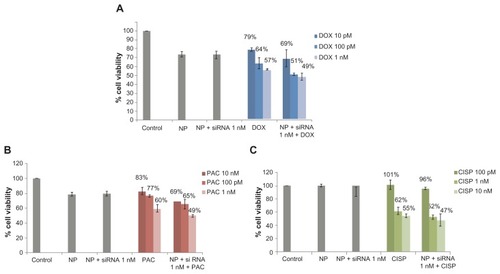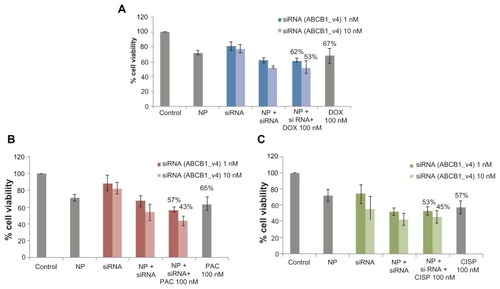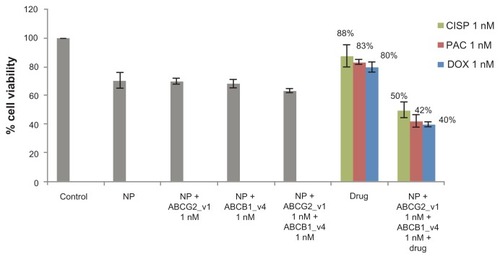Figures & data
Table 1 Role of ABCG2 knockdown in enhancing cytotoxic effects of anti-cancer drugs at 100 nM
Figure 1 Effect of carbonate apatite-mediated delivery of ABCG2-targeted siRNA (ABCG2_v1) on MCF-7 cell viability in presence of traditionally used chemotherapeutic agents. Anti-ABC siRNA-carbonate apatite complexes were generated by mixing exogenously added 3 mM calcium chloride in 1 mL bicarbonate-buffered DMEM (pH 7.4), followed by addition of anti-ABCG2 siRNA (1 or 10 nM) and incubation at 37°C for 30 minutes. Supplementation of 10% FBS was followed by addition of 100 nM of doxorubicin (A) or paclitaxel (B) or cisplatin (C).
Note: Transfection of MCF-7 cells was performed with the siRNA/nanoparticle complexes in presence of the free drugs for a consecutive period of 48 hours and viability of the cells was determined using MTT assay.
Abbreviations: NP, nanoparticles; siRNA, small interfering RNA; DOX, doxorubicin; PAC, paclitaxel; CISP, cisplatin.

Table 2 Role of ABCG2 knockdown in enhancing cytotoxic effects of anti-cancer drugs at 10 pM to 1 nM
Figure 2 Effect of carbonate apatite-mediated delivery of ABCG2-targeted siRNA (ABCG2_v1) on MCF-7 cell viability in presence of low dose of traditionally used chemotherapeutic agents. Anti-ABC siRNA-carbonate apatite complexes were generated by mixing exogenously added 3 mM calcium chloride in 1 mL bicarbonate-buffered DMEM (pH 7.4), followed by addition of anti-ABCG2 siRNA (1 nM) and incubation at 37°C for 30 minutes. Supplementation of 10% FBS was followed by addition of 10 pM, 100 pM or 1 nM of doxorubicin (A) or paclitaxel (B) or 100 pM, 1 nM, 10 nM cisplatin (C).
Note: Transfection of MCF-7 cells was performed with the siRNA/nanoparticle complexes in presence of the free drugs for a consecutive period of 48 hours and viability of the cells was determined using MTT assay.
Abbreviations: NP, nanoparticles; siRNA, small interfering RNA; DOX, doxorubicin; PAC, paclitaxel; CISP, cisplatin.

Table 3 Role of ABCB1 knockdown in enhancing cytotoxic effects of anti-cancer drugs at 100 nM
Table 4 Role of ABCB1 knockdown in enhancing cytotoxic effects of anti-cancer drugs at 10 pM to 1 nM (doxorubicin and paclitaxel) and 100 pM to 10 nM (cisplatin)
Figure 3 Effect of carbonate apatite-mediated delivery of ABCB1-targeted siRNA (ABCB1_v4) on MCF-7 cell viability in presence of traditionally used chemotherapeutic agents. Anti-ABC siRNA-carbonate apatite complexes were generated by mixing exogenously added 3 mM calcium chloride in 1 mL bicarbonate-buffered DMEM (pH 7.4), followed by addition of anti-ABCB1 siRNA (1 or 10 nM) and incubation at 37°C for 30 minutes. Supplementation of 10% FBS was followed by addition of 100 nM of doxorubicin (A) or paclitaxel (B) or cisplatin (C).
Note: Transfection of MCF-7 cells was performed with the siRNA/nanoparticle complexes in presence of the free drugs for a consecutive period of 48 hours and viability of the cells was determined using MTT assay.
Abbreviations: NP, nanoparticles; siRNA, small interfering RNA; DOX, doxorubicin; PAC, paclitaxel; CISP, cisplatin.

Figure 4 Effect of carbonate apatite-mediated delivery of ABCB1-targeted siRNA (ABCB1_v4) on MCF-7 cell viability in presence of low dose of traditionally used chemotherapeutic agents. Anti-ABC siRNA-carbonate apatite complexes were generated by mixing exogenously added 3 mM calcium chloride in 1 mL bicarbonate-buffered DMEM (pH 7.4), followed by addition of anti-ABCB1 siRNA (1 nM) and incubation at 37°C for 30 minutes. Supplementation of 10% FBS was followed by addition of 10 pM, 100 pM or 1 nM of doxorubicin (A) or paclitaxel (B) or 100 pM, 1 nM, 10 nM cisplatin (C).
Note: Transfection of MCF-7 cells was performed with the siRNA/nanoparticle complexes in presence of the free drugs for a consecutive period of 48 hours and viability of the cells was determined using MTT assay.
Abbreviations: NP, nanoparticles; siRNA, small interfering RNA; DOX, doxorubicin; PAC, paclitaxel; CISP, cisplatin.

Table 5 Role of ABCG2 and ABCB1 knockdown in enhancing cytotoxic effects of anti-cancer drugs at 1 nM
Figure 5 Combination effect of two siRNAs targeting ABCG2 and ABCB1 (ABCG2_v1 and ABCB1_v4 respectively) co-delivered with carbonate apatite nanoparticles on MCF-7 cell viability in presence of traditionally used chemotherapeutic agents. Anti-ABC siRNAs-carbonate apatite complexes were generated by mixing exogenously added 3 mM calcium chloride in 1 mL bicarbonate-buffered DMEM (pH 7.4), followed by addition of anti-ABCG2 (1 nM) and anti-ABCB1 siRNA (1 nM) and incubation at 37°C for 30 minutes. Supplementation of 10% FBS was followed by addition of 1 nM drug (doxorubicin, paclitaxel or cisplatin).
Note: Transfection of MCF-7 cells was performed with the siRNA/nanoparticle complexes in presence of the free drugs for a consecutive period of 48 hours and viability of the cells was determined using MTT assay.
Abbreviations: NP, nanoparticles; siRNA, small interfering RNA; DOX, doxorubicin; PAC, paclitaxel; CISP, cisplatin.
